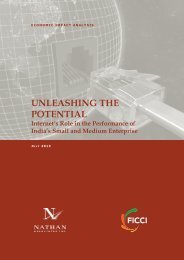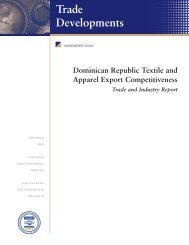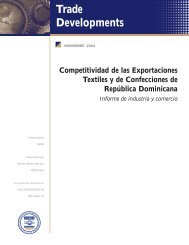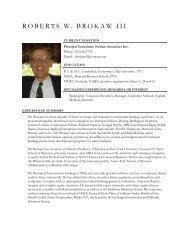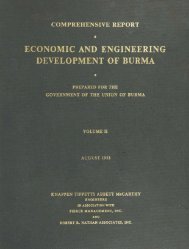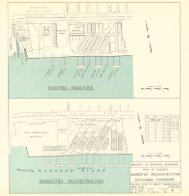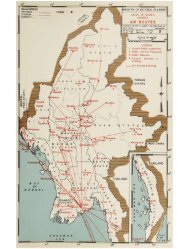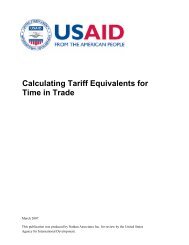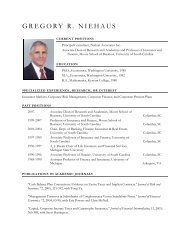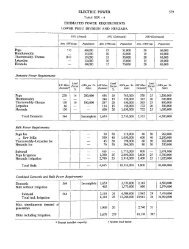Putting it to Work in Developing Countries - Nathan Associates
Putting it to Work in Developing Countries - Nathan Associates
Putting it to Work in Developing Countries - Nathan Associates
Create successful ePaper yourself
Turn your PDF publications into a flip-book with our unique Google optimized e-Paper software.
5 WIR 2004, p. 150, for a description of the wide array<br />
of services exported by develop<strong>in</strong>g countries.<br />
6 Ibid. pp. 95–96.<br />
7 Ibid. pp. 29–31.<br />
8 For a description of the impact of MFA’s closure on<br />
Lesotho’s textile and apparel sec<strong>to</strong>r, see WIR 2006,<br />
p.191. The U.S. dollar’s sharp depreciation co<strong>in</strong>cided<br />
w<strong>it</strong>h the end of the MFA regime also negatively effected<br />
Lesotho’s textile and apparel enterprises. See Michael<br />
W<strong>in</strong>es, “Dollar’s Fall Silences Africa’s Garment<br />
Fac<strong>to</strong>ries,” New York Times, March 12, 2005.<br />
9 The power of Ch<strong>in</strong>a’s textile and apparel enterprises is<br />
evidenced by the surge of Ch<strong>in</strong>ese textile and apparel<br />
exports <strong>to</strong> the Un<strong>it</strong>ed States after the lift<strong>in</strong>g of MFA—<br />
a reported 46 percent <strong>in</strong>crease <strong>in</strong> the first eight months<br />
of 2005 before U.S. impos<strong>it</strong>ion of safeguard restrictions<br />
<strong>to</strong> lim<strong>it</strong> growth. See David Kay Johnson and Ke<strong>it</strong>h<br />
Bradsher, “Ch<strong>in</strong>a and US Expected <strong>to</strong> Reach Deal on<br />
Textiles,” New York Times, November 5, 2005.<br />
10 Such considerations may expla<strong>in</strong> some of the<br />
changes <strong>in</strong> the s<strong>to</strong>ck of textile, cloth<strong>in</strong>g, and leather<br />
<strong>in</strong>dustry FDI signaled earlier.<br />
11 WIR 2006, p. 80.<br />
12 In the post-quota world, tariffs will rema<strong>in</strong>. But<br />
while developed countries’ tariffs on textiles and apparel<br />
are high, they are not prohib<strong>it</strong>ive and provide only a<br />
th<strong>in</strong> marg<strong>in</strong> of preference for goods enter<strong>in</strong>g large,<br />
developed-country markets such as the Un<strong>it</strong>ed States<br />
under NAFTA and unilateral trade preferences (e.g.,<br />
Andean Trade Preference and Drug Eradication Act,<br />
and African Growth and Opportun<strong>it</strong>y Act). These marg<strong>in</strong>s<br />
that may be less significant than the production<br />
cost advantages of large Asian suppliers. Moreover, special<br />
qualify<strong>in</strong>g rules for apparel under unilateral preferential<br />
tariff arrangements often require the use of more<br />
expensive U.S fabric, further erod<strong>in</strong>g the attractiveness<br />
of countries eligible for such preferences, unless they<br />
meet or beat the production costs <strong>in</strong> nonbeneficiary<br />
countries, or present other special advantages (e.g., just<strong>in</strong>-time<br />
capabil<strong>it</strong>y).<br />
13 UNCTAD, TNC’s and the Removal of Textiles and<br />
Cloth<strong>in</strong>g Quotas, UCTAD/ITE/IIA/2005/1, pp.20–25.<br />
For a general look at the post-MFA transformation of<br />
Africa’s apparel <strong>in</strong>dustry, see Broadman, Africa’s Silk<br />
Road, Ch<strong>in</strong>a and India’s New Economic Frontier<br />
(Advance Ed<strong>it</strong>ion), Wash<strong>in</strong>g<strong>to</strong>n, DC: World Bank<br />
(2006), pp. 149–151.<br />
14 See Don Lee, “Even Ch<strong>in</strong>ese Companies are<br />
Relocat<strong>in</strong>g <strong>to</strong> Cheaper Vietnam,” Los Angeles Times,<br />
August 18, 2006.<br />
15 See “New Policy Stresses Qual<strong>it</strong>y of Foreign<br />
Investment,” Ch<strong>in</strong>a Daily, November 10, 2006 at<br />
www.ch<strong>in</strong>adaily.com.cn/bich<strong>in</strong>a/2006-11/10/content_729989.htm;<br />
and “Ch<strong>in</strong>a’s Economy—Ch<strong>in</strong>a<br />
Wants Higher Qual<strong>it</strong>y Foreign Investment,” The<br />
Economist, November 13, 2006.<br />
16 Conclusion of a study by Morgan Stanley, c<strong>it</strong>ed <strong>in</strong><br />
“A Survey of Bus<strong>in</strong>ess <strong>in</strong> India,” The Economist, June 3,<br />
2006, p. 14.<br />
17 Ibid., pp. 15–16.<br />
18 Clive Harris, “Private Participation <strong>in</strong> Infrastructure<br />
<strong>in</strong> Develop<strong>in</strong>g <strong>Countries</strong>: Trends, Impacts, and Policy<br />
Lessons,” World Bank <strong>Work</strong><strong>in</strong>g Paper Number 5<br />
(2003), pp. 6–15.<br />
19 World Bank, Public–Private Infrastructure Advisory<br />
Facil<strong>it</strong>y, “Private Activ<strong>it</strong>y <strong>in</strong> Infrastructure shows mixed<br />
results <strong>in</strong> 2005” (September 2006).<br />
20 Even <strong>in</strong> this bust period, private <strong>in</strong>frastructure<br />
<strong>in</strong>vestments are reported <strong>to</strong> have cont<strong>in</strong>ued <strong>to</strong> advance<br />
<strong>in</strong> several low <strong>in</strong>come countries—Cameroon, Togo,<br />
Niger, Azerbaijan, and India—perhaps testimony <strong>to</strong><br />
how essential and adaptable these projects can be. See<br />
Clive Harris, “Private participation <strong>in</strong> Infrastructure <strong>in</strong><br />
Develop<strong>in</strong>g <strong>Countries</strong>: Trends, Impacts, and Policy<br />
Lessons,” World Bank <strong>Work</strong><strong>in</strong>g Paper Number 5<br />
(2003), pp. 8–9.<br />
21 On the basis of a sample survey of 35 countries, the<br />
World Bank estimated that South-South FDI amounted<br />
<strong>to</strong> $48 million <strong>in</strong> 2003 (GDF 2006,111). UNC<br />
TAD reports $37 billion <strong>in</strong> 2003 FDI receipts <strong>in</strong> develop<strong>in</strong>g<br />
and trans<strong>it</strong>ional economies from foreign<br />
<strong>in</strong>ves<strong>to</strong>rs based <strong>in</strong> these same economies, exclud<strong>in</strong>g<br />
FDI from offshore f<strong>in</strong>ancial centers (WIR 2006,<br />
117–118). Differences <strong>in</strong> how the World Bank and<br />
UNCTAD classify economies may account for some of<br />
the <strong>in</strong>consistency.<br />
22 The observations are based on WIR 2006, pp.<br />
117–136.<br />
23 Ibid. pp. 141–168.<br />
24 Harry G. Broadman, Africa’s Silk Road, Ch<strong>in</strong>a and<br />
India’s New Economic Frontier (Advance Ed<strong>it</strong>ion),<br />
Wash<strong>in</strong>g<strong>to</strong>n, DC: World Bank (2006), pp. 89–92.<br />
25 GDF 2004, pp.81–82.<br />
26 WIR 2006, pp. 198–199.<br />
27 V<strong>in</strong>cent Palmade and Andrea Anayiotas, “FDI<br />
Trends, Look<strong>in</strong>g Beyond the Current Gloom <strong>in</strong><br />
Develop<strong>in</strong>g <strong>Countries</strong>” (September 2004) at<br />
http://rru.worldbank.org/PublicPolicyJournal.<br />
97



